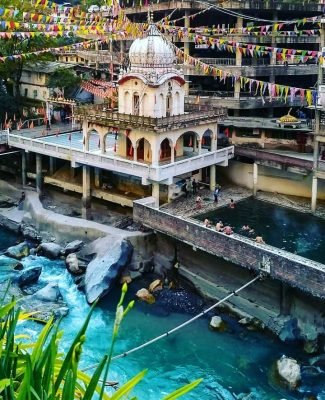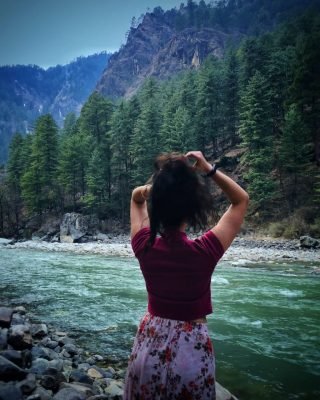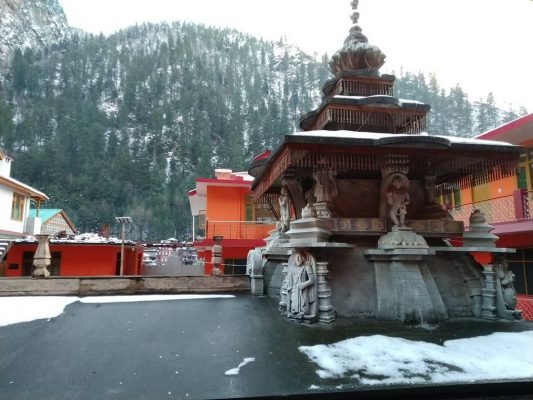In the chilling weather of Himachal, I would be found savoring the heat coming from the tiny stalls preparing warm Maggi and tea. Bundled up in layers of sweaters-mufflers and soaking up the meager sunlight glistening on the snow-covered rocks. Picturise being surrounded by steaming hot water in such a scenario. Sounds so relieving and perfect. Right?
Well, now that you have picturized it, this is exactly what Manikaran has in stock for you. A place that’s just so spiritually enlightened and exhibits nature’s wonders at its best. Located in the Parvati valley amidst the Parvati river, this little town is quite a famous tourist destination and a common halting point during Kullu-Manali exploration.
Nestled at an altitude of 1,82 meters above sea level, is the infamous hot springs. With so many speculations and stories over the years on how the water remains above the boiling point even to date, it is one of the most interesting natural wonders I’ve witnessed.
Right above the steam of the hot spring is the light beige shades of the gurdwara and the majestic domed temples. An offering made to God in here is believed to bring goodwill to you by bringing in your drowned or lost goods floating back to you.
A good share of the river water is used by the villagers, and there is always non-stop activity around here. I was told that the water here could be used for cooking rice just by leaving the rice tied up in a muslin cloth in the water. I didn’t know if I had to be terrified of walking around these waters because all I could think was “That’s the coolest thing I’ve seen in a long while.” Figuratively, not literally of course.
Going in search of stories
Be it for pilgrims or explorers, this small town would be the kind that would capture your fascination. Several legends are revolving around the hot spring. One among them revolves around the waters having washed down Lord Shiva’s wrath which he had released by opening his legendary third eye.
Born out of many such intriguing ancient beliefs, there are several scientific explanations to this phenomenon as well. Since it arises from the deep fissures in the valley, the water passing through the hot rocks beneath Earth increases the water’s temperature and also makes it highly radioactive. Due to all these properties, the waters are believed to be a beneficial cure to people suffering from joint pains and ailments.
Table of Contents
Route to Manikaran
Taking a flight to Himachal always lands you at the Kullu-Manali Airport. While there are also the Gaggal and Bhuntar airports, this is the closest route to Manikaran. Located at a distance of 35 km from Manikaran, the valley is easily accessible through cabs and other public transport options available.
This airport is recommended as they also have frequent domestic flights from Delhi and Shimla.
In case you want to travel via railway networks, the Joginder Nagar station is situated roughly 130 km from the town. There is a dependable amount of well connected and maintained roads to Manikaran, and so also an abundance of bus services by the Himachal Road Transport Corporation. This is comparatively a more feasible and safer option than the private-owned buses which also have frequent shifts around the town.
The ideal time to visit
Even though the warmth of the hot spring would keep you going around the seasons, it is best to visit the place during summers. The temperature scale often shoots down unprecedentedly during winters and can get quite harsh if you’re not prepared for it. Summer from March till June gives a bearable amount of cold with occasional rays of sunshine to soak up in. This is also quite ideal if you would like to indulge in activities such as paragliding, mountain sports, skiing, and so on, in the nearby Solang valley.
5 must-visit places around Manikaran
Leave behind the usuals of Manali and Kasol, and get captivated by these 5 activities that feel like a fresh breath of air.
1) Manikaran Sahib

This place holds a special place in my heart for various reasons. The warmth with which I was welcomed here. Timeless Sikh stories hung in the form of portraits. Prayers that still echo whenever I think of the place. And of course, the scrumptious langar that filled my heart.
Situated in the Parvathi valley, the place of worship welcomes you through a bridge right across the hot spring. The fluttering of the colorful flags hung from the Gurdwara and the prayer chants echoing from within is an unforgettable spiritual experience.
You would have to remove your shoes and cover your head to enter the prayer hall. In case you have no cloth to wrap your head, they’d themself provide you with a white piece of cloth. Walking barefoot into the carpeted hall and watching the guru recite prayers in front of the Guru Grant Sahib was spiritual in every sense. Wrapping up the prayer session, I instinctively walked downstairs to the Langar hall.
You can be of great help here, by volunteering to serve or wash the dishes. There’s always helping hands at the Gurdwara, and you can be a part of this service. Everything from the plates to the dishes comes to you with the utmost care of hygiene. Utensils are washed by sterilizing them in four counters of soap and warm water. The food is prepared by the volunteers after ensuring the grains and pulses are clean.
The aroma of the food being cooked surrounded me and I sat on the mat like a happy 5year old waiting for her favorite food. Volunteers came by constantly to re-serve the empty thali’s. To date, it was the most contending platter of food I’ve had. Authentic style North Indian thali of white rice, rotis, kadhi, and aloo sabzi.
While I sat there devouring the meal, a friend sitting across narrated the legacy behind the preparation of Langar here. It’s believed that the great Guru Nanak Dev Ji, had visited Manikaran along with his disciple Bhai Mardana.
Mardana was asked to collect flour and necessary pulses to cook a decent meal for the people. On returning, Mardana had removed a stone where Guru Nanak was previously sitting upon, and out from there emerged the hot spring. He cooked the meal with the help of the spring and served it.
Even today, many people cook their food by keeping it immersed in the spring. Yet another selfless act I noticed was that, not only do they provide free food but also arrange a stay for those who would want a place to spend their day at.
2) Hot Springs

If you were left mesmerized watching the hot springs flowing outside the Gurudwara, you’re in for more surprises. Setup in the form of a natural jacuzzi in the bath inside the Gurudwara. Not only are they radioactive but are also said to contain elements of sulfur which is refreshing and energizing.
And not to mention just how peaceful I felt being around the warmth of the water after walking around the snow for two days. From the cold, the switch to the hot temperature would take a while to be adjusted by your body.
There are separate sections for men and women. The washrooms are also facilitated with the water that comes from these springs. Like the Ganges, the hot springs are also considered holy and many people come around here to take a dip and get salvation from their sins. A bath here for beyond 10 minutes is not highly recommended due to its elemental properties. The body might not be able to accommodate the change in water unlike those who come around here regularly.
The myths have it that Goddess Parvathi had lost her favorite gem in the waters and was distressed on not being able to find it amidst the strong currents. An infuriated Lord Shiva opened his third eye and danced Tandava around here to destroy everything. Sheshnag, the God of snakes, to calm down Shiva, released spring of hot water which led the gem to come to the surface. Whether the myths are true or not, the villagers sure are blessed to have 24*7 natural running hot water.
3) Lord Shiva Temple

Carved out of stone, is the iconical Shiva sculpture at the Shiva Mandir in Manikaran. The steam rising from the hot springs creates a clouded view of the structure, which gives a very mystical vibe to it.
Aadi epics in the Ramayana has it that Ram used to frequently travel to Manikaran to worship Lord Shiva. The stories about god’s coming to Manikaran for offering prayers makes it a lot more of a spiritual experience. The age-old myths living within the antiquity of the structures always made me feel that the soul of Manikaran truly lies within these walls of the Gurudwara and the temples.
At an altitude of 2650 meters above sea level, the temple is an exemplar in Pahadi architecture. It has stood tall against several natural disasters and is still intact as the most revered temple in Manikaran. I was told that Lord Shiva along with his wife Goddess Parvathi had made this spot their abode for around 1100 years. The myths also have it that the most respected gods and goddesses of Kullu valley pay a visit to the temple from time to time.
4) Parvati river and Harinder mountains

Parvati Valley is also known as Kheer Ganga (Khir Ganga) getting the name from milk like water flow. The town is perched right over the banks of River Parvathi and so it sure makes it to the list of unmissable spots around Manikaran. Even though there’s a line of activities that keeps happening around, the river flows surreally in an untouched manner. People often come around here o sit by the rocks and relax.
With the majestic Harinder mountain ranges encircling the river, it is a sight that’d be etched in your mind forever. The snow-capped mountains themself look like a curtain made out of pearl dust. Just located at walking distance from the river, this mountain peak gives an eagle’s eye view of the entire town as well.
The place is also perfect for a short adventurous trek. With their misty trails and towering stone structures amidst the forests.
Yet another interesting feature here is that many people have painted the rocks around here and blotted them with abstract forms of tribal art. Make sure you don’t miss out on the heavenly experience of taking a peaceful stroll around the sun-kissed river.
5) Lord Ramachandra Temple

Built by Raja Jagat Singh in the 17th century. This is the second infamous place of Hindu worship after the Lord Shiva temple. This splendid structure is situated right at the heart of the town. It is said to fulfill every prayer that is made to the deity with a good thought of mind.
The temple is a structure that houses around 40 rooms. It also arranges langar for the empty stomachs who come here. With idols of Lord Ram and Sita, adorned in the Kullu tradition. The temple lives to its legend that the abode of worship was brought from Ayodhya by Lord Ram himself.
The temperature around here falls to around 10° C. During summers and winters are pretty harsh to enjoy the place in its complete essence. If it interests you, you could also visit the Kulant pith nearby. Which is said to be the most sacred piths in India. Barely 40 km from the Kullu bus stand, is this mesmerizing structure.
Lord Shiva is believed to have blessed this place by staying here for a short span. Right around here you’d also be able to spot the Vishnu Kund. The placement of this interested me particularly as both are the symbols of Stithi-Samhara (Preservation-Destruction).
Localities here believe that every form of negative energy and emotions. Such as anger and ill-thoughts get washed away by taking a dip in the Kund.
The waters are said to be among the holiest. That even one drop of it would grant you salvation and pave the way to heavens after death.
Apart from the usual pilgrim crowd, the pith is quite peaceful. Manikaran is an unparalleled experience. Legends and myths are hidden around every nook and corner. Waiting to be dusted and discovered by the people who come by.

